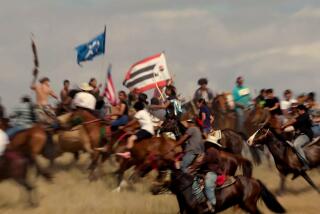Historic Tunic Goes Home to Lakota Sioux
- Share via
GLASGOW, Scotland — After a century of exile, Glasgow’s famous “ghost shirt” is going home to Wounded Knee.
A mixed band of spectators, some in kilts and some in cowboy boots, burst into applause earlier this month as the City Council of this industrial center agreed that a bloodstained Indian tunic worn by a victim of the 1890 Wounded Knee massacre should be handed over to the Lakota Sioux reservation in Pine Ridge, S.D. The shirt has been in Glasgow’s municipal museum since a member of Buffalo Bill’s Wild West Show donated it in 1892.
“This is a day of great thanksgiving for the Lakota,” said Marcella Le Beau of Eagle Butte, S.D., secretary of the Wounded Knee Survivors’ Assn. “I want to cry for joy.”
The decision may not be viewed as joyful, however, by directors of museums all over Europe, where Native American artifacts are common and extremely popular.
“A significant number of people in the museum world will feel threatened by this,” noted Mark O’Neill, chief curator of Glasgow’s municipal museums. “They are afraid this undermines our right to keep . . . objects from other cultures.”
O’Neill insisted that the return of the tunic--one of the best-known surviving relics of Wounded Knee--does not set a precedent for other objects and other museums. “We have a right to own and show this shirt in perpetuity, but the people of Glasgow are not required to exercise that right,” he said.
In the last two decades of the 19th century, Europeans were enthralled by the American West, and museums scrambled for cowboy-and-Indian artifacts.
Glasgow was persuaded to give up its relic--which boasts a gallery of its own amid an eclectic collection of Egyptian mummies, stuffed local wildlife and ‘ antique furniture in the city’s Kelvingrove Museum--after Indians argued that the shirt is a singularly important piece of history. There are several Sioux ghost shirts in museums today, including the Smithsonian. But the Glasgow shirt is the only one that has been connected to the massacre at Wounded Knee.
The sandy brown tunic, decorated with eagle feathers and maroon fringe, was worn by followers of the Ghost Dance religion. The Ghost Dancers had been told by their priests that the white man’s weapons could not harm anyone wearing the ghost shirts.
This proved horribly wrong on the last two days of 1890, when soldiers of the Seventh Cavalry attacked a band of Sioux near the creek at Wounded Knee. About 250 Sioux were killed, including women and children. Soldiers plundered the clothes and weapons of the dead and threw the naked corpses into mass graves.
A year later, William “Wild Bill” Cody brought his Wild West Show to Glasgow during a triumphant tour of Europe. A cowboy member of the troupe, George Crager, brought along a trunk containing memorabilia of Wounded Knee. He donated several of the items, including the ghost shirt, to the city.
Six years ago, an American tourist--a Cherokee named John Earl--walked into the Ghost Shirt Gallery in the municipal museum and was stunned by what he saw.
“I have no objection to museums showing artifacts that have been legitimately obtained,” Earl said. “But I felt very, very strongly that this item should go home. It had been stolen from a dead body at Wounded Knee.”
The City Council began to rethink its right of ownership after Le Beau led a Lakota delegation to Glasgow in 1995. The Sioux performed a ceremony of blessing over the shirt and argued that its historical significance means it belongs in South Dakota.
This month, Le Beau led another delegation of Native Americans to Glasgow. This time, she and her companions won the day.
“They had such a quiet dignity about them,” said Liz Cameron, chairman of the City Council’s Arts and Culture Committee. “They demonstrated a deep respect for the history and religion of the Scottish people. We decided that we should emulate them and display our own respect for American Indian culture.”
More to Read
Sign up for Essential California
The most important California stories and recommendations in your inbox every morning.
You may occasionally receive promotional content from the Los Angeles Times.













